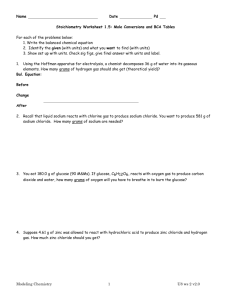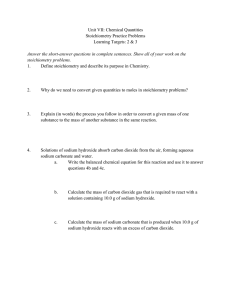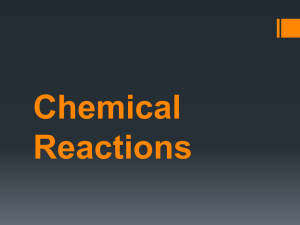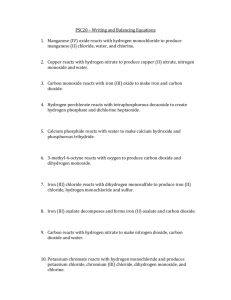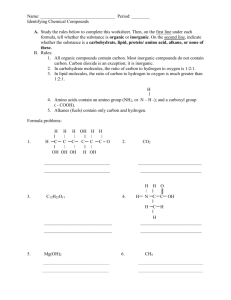CHEMICAL FORMULAS AND REACTIONS
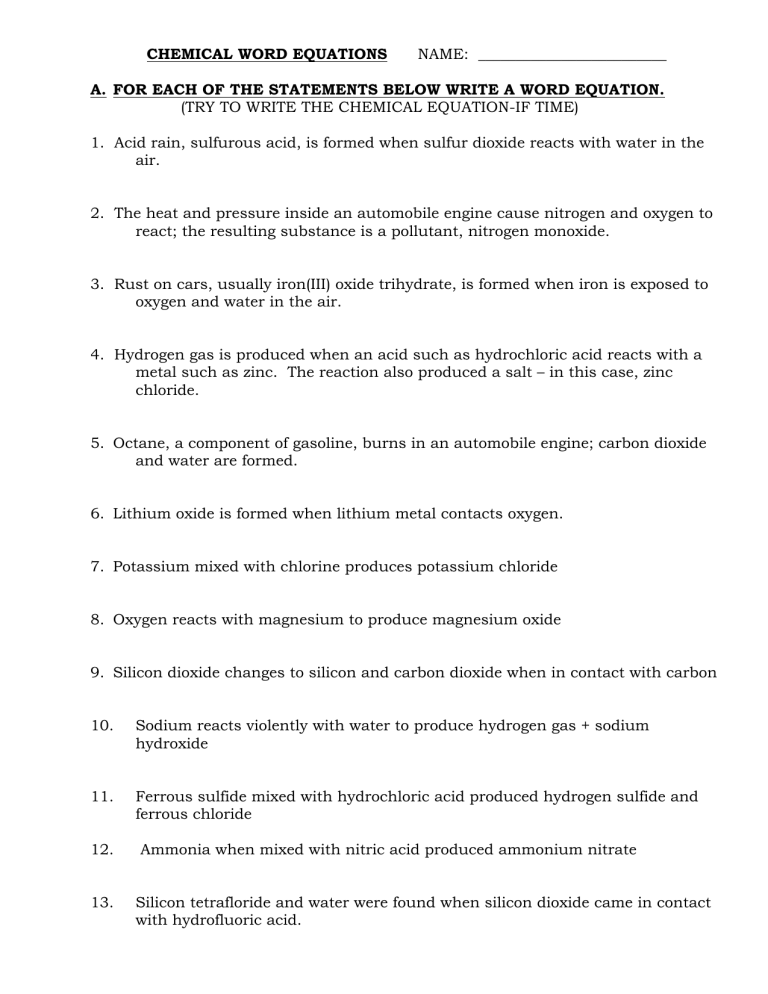
CHEMICAL WORD EQUATIONS NAME: _________________________
A.
FOR EACH OF THE STATEMENTS BELOW WRITE A WORD EQUATION.
(TRY TO WRITE THE CHEMICAL EQUATION-IF TIME)
1. Acid rain, sulfurous acid, is formed when sulfur dioxide reacts with water in the air.
2. The heat and pressure inside an automobile engine cause nitrogen and oxygen to react; the resulting substance is a pollutant, nitrogen monoxide.
3. Rust on cars, usually iron(III) oxide trihydrate, is formed when iron is exposed to oxygen and water in the air.
4. Hydrogen gas is produced when an acid such as hydrochloric acid reacts with a metal such as zinc. The reaction also produced a salt – in this case, zinc chloride.
5.
Octane, a component of gasoline, burns in an automobile engine; carbon dioxide and water are formed.
6.
Lithium oxide is formed when lithium metal contacts oxygen.
7.
Potassium mixed with chlorine produces potassium chloride
8.
Oxygen reacts with magnesium to produce magnesium oxide
9.
Silicon dioxide changes to silicon and carbon dioxide when in contact with carbon
10.
Sodium reacts violently with water to produce hydrogen gas + sodium hydroxide
11.
Ferrous sulfide mixed with hydrochloric acid produced hydrogen sulfide and ferrous chloride
12.
Ammonia when mixed with nitric acid produced ammonium nitrate
13.
Silicon tetrafloride and water were found when silicon dioxide came in contact with hydrofluoric acid.
B.
EXOTHERMIC vs. ENDOTHERMIC REACTIONS
ALL CHEMICAL REACTIONS INVOLVE CHANGES IN ENERGY.
ENERGY IS EITHER _________________ OR _______________IN A CHEMICAL REACTION
EXOTHERMIC REACTIONS:
IS WHERE ENERGY IS_________________. HEAT IS RELEASED OR GIVEN OFF.
**MOST OF THE CHEMICAL REACTIONS
IE: COMBUSTION of wood, natural gas, etc..
NATURAL GAS BURNS TO PRODUCE HEAT
___________________ +___________________ ____________ + ______________
AN EXPLOSION OF NITROGLYCERIN
Nitroglycerin → ____ + _____ + ______ + _______
TNT (trinitrotoluene)
C
7
H
5
N
3
O
6
(
S
) 12 CO + 5 H + 3 N +2 C + energy
CORROSION: RUSTING OF METALS
_________________+ _______________+ __________________ ____________________
RESPIRATION: Is a chemical reaction that takes place in the cells in your body.
________+ __________ ________________+ ________________ (_________________)
C
6
H
12
O
6(s)
+ O
2
→ CO
2
+ H
2
O
COMPOST:
NEUTRALIZATION OF ACIDS AND BASES:
Hot packs: generally use calcium chloride (CaCl
2
)
ENDOTHERMIC REACTIONS:
IS WHERE ENERGY IS __________________ IN A CHEMICAL REACTION.
***ARE LESS COMMON
IE: ELECTROYSIS: OF WATER
__________ ____________ + ____________ 2
2 H
2
O O
2
+ 2 H
2
PHOTOSYNTHESIS: THE MAKING OF GLUCOSE IN PLANTS
_____________+ ____________ _______________________+________________
6CO
2(g)
+ 6 H
2
O
(l)
→ C
6
H
12
O
6(s)
+ 6O
2(g)
COOKING FOOD:
BAKING SODA WHEN USED IN COOKING ABSORBS ENERGY WHEN HEATED.
IT RELEASES CARBON DIOXIDE AND WATER (STEAM).
COLD PACKS: generally use ammonium nitrate (NH
4
NO
3
)
DECOMPOSITION: of limestone to make lime
(increase soil pH level and make cement)
Limestone lime + carbon dioxide
CaCO
Salt
2NaCl
3(s)
sodium + chlorine
(s)
+ heat
2Na
(l)
CaO + CO
+ Cl
2(g)
2(g)
C. MATCH THE CHEMICAL FORMULA WITH THE COMMON NAME OF THE
SUBSTANCE.
COLUMN A COLUMN B
___ baking soda (sodium hydrogen carbonate) a. NaCl
(s)
___ water
___ carbon dioxide
___ carbon monoxide
___ table salt (sodium chloride)
___ bleach (sodium hypochlorate)
___ chalk or limestone(calcium carbonate) b. NaOCl
(aq) c. O
2(g) d. C
2
H
4
O
2(aq) e. NaHCO
3(s) f. H
2
O
2(l) g. C
6
H
12
O
6(s)
___ oxygen gas
___ hydrogen peroxide
___ vinegar (acetic acid)
___ glucose (sugar)
___sodium hydroxide h. CO
2(g) i. H
2
O
(l) j. CaCO
3(s) k. CO
(g) l. NaOH
D.
READ PAGE 107 and 110 and answer these questions.
1.
LAVOISIER’S “LAW OF DEFINITE COMPOSITION” means that _________________ are pure substances that contain _______ or __________ elements combined together in _________________(or __________________)
_____________________________.
2. Water is used to explain definite composition. When electricity is used to decompose compounds it is known as _______________________. Diagram out the experiment at the front of the class. The reactant is __________ and the products are _____________________ and _________________. The word equation for this chemical reaction is ________________(l) ____________(g)+_________________(g).
3.
LAVOISIER’S “LAW OF CONSERVATION OF MASS” states that, in a chemical change, the _____________ ______________ of the ______ ___________________ is
ALWAYS EQUAL to the ___________ _________________ of the _______________
_____________
4. Prep and do lab on page 108.
